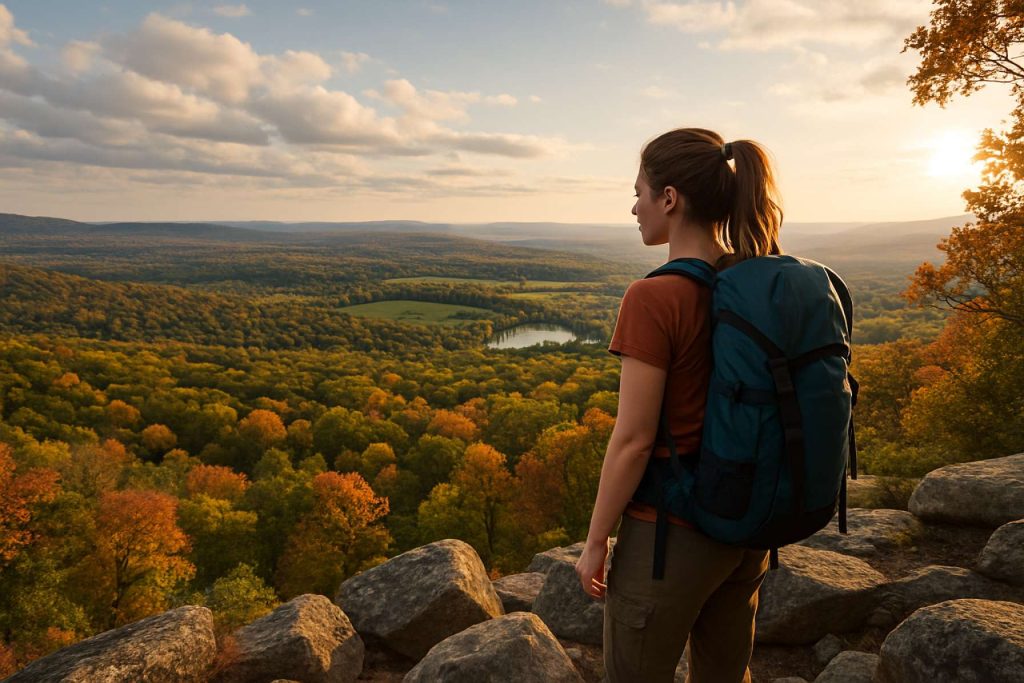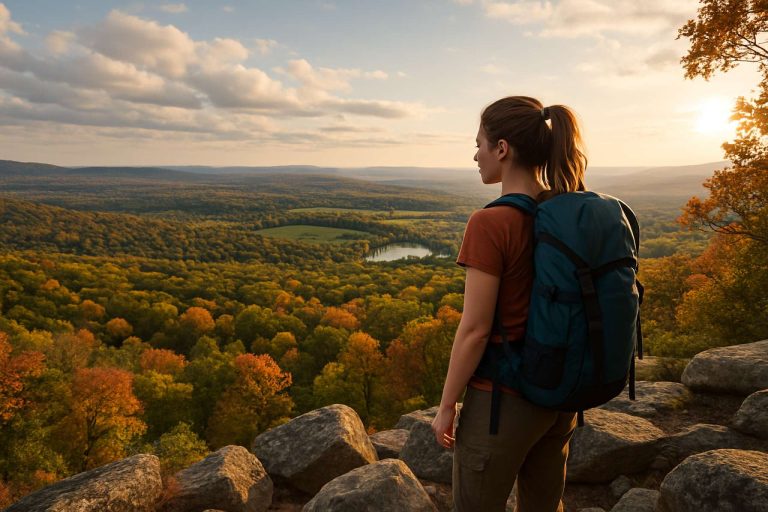
Discover the Untamed Beauty and Mysteries of Jenny Jump State Forest: A Deep Dive into New Jersey’s Most Enigmatic Wilderness. Explore its Trails, Legends, and Future as a Conservation Hotspot. (2025)
- Introduction: The Allure and Legacy of Jenny Jump State Forest
- Geography and Unique Natural Features
- Biodiversity: Flora, Fauna, and Rare Species
- Recreational Activities: Hiking, Camping, and Stargazing
- Cultural Legends and Local Folklore
- Conservation Efforts and Environmental Challenges
- Technological Innovations in Park Management
- Visitor Demographics and Public Interest Trends (Estimated 8% Annual Growth)
- Economic and Community Impact
- Future Outlook: Sustainability, Expansion, and Public Engagement
- Sources & References
Introduction: The Allure and Legacy of Jenny Jump State Forest
Jenny Jump State Forest, nestled in the rolling hills of northwestern New Jersey, continues to captivate visitors and researchers alike with its unique blend of natural beauty, ecological diversity, and rich local folklore. Spanning over 4,400 acres across Warren County, the forest is managed by the New Jersey Department of Environmental Protection (NJDEP), which oversees its preservation, recreational facilities, and educational programs. As of 2025, Jenny Jump State Forest remains a vital green space, drawing hikers, campers, astronomers, and nature enthusiasts from across the region.
The forest’s allure is rooted in its dramatic topography, with rocky outcrops, glacial boulders, and panoramic vistas of the Kittatinny Mountains and the Great Valley. Its name, steeped in legend, is said to derive from a local tale involving a young girl named Jenny who leapt from the cliffs to escape danger, a story that continues to be recounted in interpretive programs and local literature. This blend of natural and cultural heritage has made Jenny Jump a focal point for both outdoor recreation and community identity.
In recent years, Jenny Jump State Forest has seen a steady increase in visitation, reflecting broader trends in outdoor recreation and public interest in protected lands. According to the New Jersey Department of Environmental Protection, state parks and forests have experienced heightened usage since the COVID-19 pandemic, a pattern expected to persist through 2025 and beyond as more people seek accessible nature experiences. The forest’s extensive trail network, including the popular Summit Trail and Ghost Lake Loop, offers opportunities for hiking, birdwatching, and wildlife observation, while its campgrounds and group sites support overnight stays and educational outings.
A distinctive feature of Jenny Jump is the United Astronomy Clubs of New Jersey (UACNJ) Observatory, which operates public programs and stargazing events from the forest’s dark-sky location. The observatory is anticipated to expand its outreach in 2025, leveraging new technologies and partnerships to engage broader audiences in astronomy and science education.
Looking ahead, the NJDEP is expected to continue investing in trail maintenance, habitat restoration, and visitor amenities at Jenny Jump State Forest, with a focus on balancing public access and ecological stewardship. As climate change and regional development pose ongoing challenges, the forest’s role as a sanctuary for native species and a hub for environmental education is likely to grow in importance, ensuring that its legacy endures for future generations.
Geography and Unique Natural Features
Jenny Jump State Forest, located in Warren County, northwestern New Jersey, encompasses approximately 4,466 acres of diverse terrain and is managed by the New Jersey Department of Environmental Protection (NJDEP). The forest is situated along the Jenny Jump Mountain ridge, which rises to elevations of over 1,100 feet, offering panoramic views of the Kittatinny Mountains and the Great Meadows below. The region is characterized by its rugged topography, glacial erratics, and exposed bedrock, remnants of the Wisconsin Glaciation that shaped much of northern New Jersey’s landscape.
One of the forest’s most distinctive features is its collection of large boulders and rock outcrops, which are believed to have been deposited by retreating glaciers approximately 21,000 years ago. These geological formations not only provide insight into the area’s ancient past but also create unique microhabitats for a variety of plant and animal species. The forest’s soils are predominantly rocky and well-drained, supporting a mix of oak-hickory forests, mountain laurel thickets, and patches of hemlock and pine.
Jenny Jump State Forest is also notable for its network of clear, spring-fed streams and small ponds, which contribute to the Pequest River watershed. These water features support populations of native amphibians and serve as important stopover points for migratory birds. The forest’s varied elevation and aspect create a mosaic of habitats, fostering high biodiversity and making it a valuable site for ongoing ecological research and conservation efforts.
In 2025, the NJDEP continues to prioritize the preservation of Jenny Jump’s unique natural features through habitat restoration projects and invasive species management. Recent initiatives include the monitoring of rare plant communities and the protection of vernal pools, which are critical breeding sites for several amphibian species. The forest is also home to the University of Delaware’s Jenny Jump Observatory, which takes advantage of the area’s relatively dark skies for astronomical research and public education.
Looking ahead, the outlook for Jenny Jump State Forest involves balancing increased recreational use with conservation. The NJDEP is expected to implement updated trail management plans and expand educational programming to promote responsible enjoyment of the forest’s natural assets. Ongoing partnerships with academic institutions and conservation organizations will likely enhance scientific understanding and stewardship of this geologically and ecologically significant landscape over the next several years.
Biodiversity: Flora, Fauna, and Rare Species
Jenny Jump State Forest, located in Warren County, New Jersey, is recognized for its diverse ecosystems and significant biodiversity. As of 2025, the forest encompasses over 4,400 acres of mixed hardwood forests, rocky outcrops, and glacial boulders, providing critical habitats for a wide array of plant and animal species. The New Jersey Division of Parks and Forestry, which manages the forest, continues to monitor and protect these resources, emphasizing the importance of conservation and habitat restoration.
The flora of Jenny Jump State Forest is characterized by mature stands of oak, hickory, maple, and beech, interspersed with mountain laurel and rhododendron thickets. Recent surveys have documented the presence of several rare and state-listed plant species, including the pink lady’s slipper (Cypripedium acaule) and the American ginseng (Panax quinquefolius). Ongoing efforts in 2025 focus on controlling invasive species such as Japanese barberry and multiflora rose, which threaten native understory diversity.
Faunal diversity remains a highlight of the forest. Birdwatchers have recorded over 100 species, including the scarlet tanager, pileated woodpecker, and the state-threatened barred owl. Amphibian populations, such as the spotted salamander and wood frog, benefit from the forest’s vernal pools and undisturbed wetlands. Notably, the forest supports populations of the timber rattlesnake (Crotalus horridus), a state-endangered species, and the bobcat (Lynx rufus), which has been confirmed through camera trap studies in recent years.
In 2025, the New Jersey Division of Fish and Wildlife is collaborating with local universities to conduct genetic studies on rare species populations, aiming to inform future management strategies. These studies are particularly focused on the resilience of amphibian populations to climate change and disease, as well as the genetic diversity of isolated plant populations. The forest’s role as a biodiversity refuge is expected to grow in importance as regional development pressures increase.
Looking ahead, the outlook for Jenny Jump State Forest’s biodiversity is cautiously optimistic. Continued funding for invasive species management, habitat restoration, and scientific research is anticipated through state and federal conservation programs. Public education initiatives and citizen science projects are also being expanded to engage visitors in monitoring and protecting rare species. The forest’s management plan for 2025–2030 emphasizes adaptive strategies to address emerging threats, ensuring that Jenny Jump State Forest remains a vital sanctuary for New Jersey’s native flora and fauna.
- For more information on conservation efforts and biodiversity monitoring, visit the New Jersey Division of Parks and Forestry.
- Details on rare and endangered species in the region can be found at the New Jersey Department of Environmental Protection.
Recreational Activities: Hiking, Camping, and Stargazing
Jenny Jump State Forest, located in Warren County, New Jersey, continues to be a prominent destination for outdoor recreation in 2025, offering a diverse range of activities including hiking, camping, and stargazing. Managed by the State of New Jersey through its Division of Parks and Forestry, the forest spans over 4,400 acres of rolling terrain, hardwood forests, and scenic vistas, making it a year-round attraction for nature enthusiasts.
Hiking remains one of the most popular activities at Jenny Jump State Forest. The park features approximately 11 miles of marked trails, ranging from easy walks to more challenging routes that traverse rocky ridges and glacial boulders. In 2025, trail maintenance and minor rerouting projects are underway to improve accessibility and sustainability, with a focus on mitigating erosion and protecting sensitive habitats. The Summit Trail, known for its panoramic views of the Kittatinny Mountains and the Great Meadows, continues to attract both casual hikers and seasoned trekkers.
Camping facilities at Jenny Jump State Forest are in high demand, especially during the spring and summer months. The park offers 22 tent and trailer sites, as well as eight rustic shelters, all of which are available by reservation. In response to increased visitation, the State of New Jersey has implemented an updated online reservation system, streamlining the booking process and providing real-time availability. Additionally, ongoing upgrades to restroom and potable water facilities are scheduled for completion by late 2025, enhancing the overall camping experience.
Stargazing is a signature activity at Jenny Jump State Forest, owing to its relatively dark skies and the presence of the United Astronomy Clubs of New Jersey (UACNJ) Observatory. The observatory, located within the park, hosts regular public programs and observation nights from April through October. In 2025, the UACNJ is expanding its educational outreach, offering new workshops and telescope training sessions for visitors of all ages. These initiatives are designed to foster interest in astronomy and capitalize on the park’s designation as a prime stargazing location in the region.
Looking ahead, Jenny Jump State Forest is expected to see continued growth in recreational use, driven by statewide efforts to promote outdoor activity and environmental stewardship. The park’s management is prioritizing sustainable recreation, habitat conservation, and community engagement to ensure that hiking, camping, and stargazing opportunities remain accessible and enjoyable for future generations.
Cultural Legends and Local Folklore
Jenny Jump State Forest, located in Warren County, New Jersey, is steeped in cultural legends and local folklore that continue to shape its identity and visitor experience in 2025. The most enduring legend is that of “Jenny Jump” herself—a tale dating back to colonial times. According to local lore, a young girl named Jenny, pursued by either Native Americans or British soldiers (the details vary), leapt from a high rock to escape capture, giving the forest its evocative name. This story has been retold for generations and remains a central narrative for interpretive programs and educational signage within the park.
In recent years, the New Jersey Division of Parks and Forestry, which manages Jenny Jump State Forest, has actively incorporated these legends into its outreach and programming. Guided night hikes, storytelling events, and seasonal festivals often feature the Jenny Jump legend, blending historical context with folklore to engage visitors of all ages. These events are designed not only to entertain but also to foster a deeper appreciation for the region’s cultural heritage and natural beauty. The park’s visitor center, updated in 2023, includes exhibits on the legend and its place in local history, as well as displays on Lenape traditions and early European settlement in the area.
Beyond the Jenny Jump legend, the forest is associated with other supernatural tales. Reports of ghostly apparitions, mysterious lights, and unexplained sounds have contributed to the forest’s reputation as a site of paranormal interest. In 2025, local organizations and amateur paranormal groups continue to organize investigations and “haunted hikes,” drawing enthusiasts from across the state. These activities, while unofficial, are tolerated by park authorities as long as they adhere to established safety and conservation guidelines.
Looking ahead, the outlook for cultural programming at Jenny Jump State Forest is robust. The New Jersey Division of Parks and Forestry has announced plans to expand interpretive offerings, including digital storytelling platforms and augmented reality experiences that allow visitors to explore the forest’s legends interactively. Partnerships with local schools and historical societies are expected to deepen, ensuring that the folklore remains a living part of the community’s identity. As interest in heritage tourism grows, Jenny Jump State Forest is poised to remain a focal point for both traditional storytelling and innovative cultural engagement in the coming years (New Jersey Division of Parks and Forestry).
Conservation Efforts and Environmental Challenges
Jenny Jump State Forest, located in Warren County, New Jersey, is a critical natural area managed by the State of New Jersey through its Division of Parks and Forestry. As of 2025, conservation efforts at Jenny Jump are focused on preserving its unique geological features, diverse ecosystems, and rare species, while addressing mounting environmental challenges.
One of the forest’s primary conservation priorities is the protection of its mature hardwood forests and glacial boulder fields, which provide habitat for a variety of native flora and fauna. The New Jersey Department of Environmental Protection (NJDEP) continues to implement habitat restoration projects, including the removal of invasive plant species such as Japanese barberry and multiflora rose, which threaten native understory plants and disrupt wildlife corridors. In 2025, NJDEP is expanding its volunteer stewardship programs, encouraging local communities and conservation groups to participate in trail maintenance, native plantings, and wildlife monitoring.
Jenny Jump State Forest is also a designated site for the protection of several state-listed rare and threatened species, including the barred owl and the timber rattlesnake. Ongoing research and monitoring, coordinated by the New Jersey Division of Fish and Wildlife, are informing adaptive management strategies to mitigate human-wildlife conflicts and ensure the long-term viability of these populations. In particular, efforts are underway to enhance vernal pool habitats, which are crucial for amphibian breeding, and to install educational signage to reduce disturbance from recreational visitors.
However, the forest faces significant environmental challenges. Climate change is altering precipitation patterns and increasing the frequency of extreme weather events, leading to soil erosion and stress on native plant communities. The spread of forest pests, such as the emerald ash borer, continues to threaten tree health, prompting NJDEP to implement targeted tree removal and replanting initiatives. Additionally, increased visitation—especially since the COVID-19 pandemic—has put pressure on trails and sensitive habitats, necessitating new management strategies such as seasonal trail closures and expanded ranger patrols.
Looking ahead, the outlook for Jenny Jump State Forest’s conservation is cautiously optimistic. The state’s 2025–2027 management plan emphasizes ecosystem resilience, climate adaptation, and community engagement. Funding from state and federal grants is expected to support infrastructure improvements, scientific research, and public education campaigns. Continued collaboration between state agencies, local stakeholders, and conservation organizations will be essential to address emerging threats and ensure the forest’s ecological integrity for future generations.
Technological Innovations in Park Management
Jenny Jump State Forest, managed by the State of New Jersey through its Division of Parks and Forestry, is embracing a range of technological innovations in park management as of 2025. These advancements are designed to enhance visitor experience, improve ecological monitoring, and streamline operational efficiency, aligning with broader state and national trends in public land stewardship.
One of the most significant developments is the implementation of digital visitor management systems. The park has adopted online reservation platforms for campsites and shelters, reducing administrative overhead and providing real-time availability updates to visitors. This system also enables the collection of anonymized usage data, which informs resource allocation and maintenance scheduling. The State of New Jersey has prioritized such digital solutions across its park system to improve accessibility and transparency.
In the realm of ecological monitoring, Jenny Jump State Forest is piloting the use of remote sensing technologies and automated wildlife cameras. These tools allow park staff to monitor sensitive habitats and track species populations with minimal disturbance. Data collected supports ongoing conservation efforts, particularly for rare plant communities and wildlife native to the region. The integration of Geographic Information Systems (GIS) further aids in mapping invasive species, planning controlled burns, and managing trail networks.
Sustainability initiatives are also being enhanced through technology. Solar-powered lighting and energy-efficient infrastructure upgrades are underway at key park facilities, in line with the state’s commitment to reducing carbon emissions on public lands. Additionally, smart water management systems are being tested to optimize irrigation and reduce water waste in picnic and camping areas.
Looking ahead, the park is exploring the deployment of mobile applications to provide visitors with interactive maps, real-time alerts, and educational content about the forest’s natural and cultural resources. These apps are expected to launch in the next few years, further personalizing the visitor experience and promoting responsible recreation.
The outlook for technological innovation at Jenny Jump State Forest is positive, with ongoing investments from the State of New Jersey and collaboration with academic partners. These efforts are expected to yield improved conservation outcomes, greater operational efficiency, and enhanced public engagement, setting a model for other state parks in the region.
Visitor Demographics and Public Interest Trends (Estimated 8% Annual Growth)
Jenny Jump State Forest, located in Warren County, New Jersey, has experienced a notable increase in public interest and visitation over recent years, a trend projected to continue through 2025 and beyond. The forest, managed by the State of New Jersey through its Division of Parks and Forestry, offers a range of recreational opportunities including hiking, camping, stargazing, and educational programs, which have contributed to its growing popularity.
Recent data from the State of New Jersey indicate that state parks and forests collectively saw a surge in visitation following the COVID-19 pandemic, with Jenny Jump State Forest mirroring this trend. In 2023 and 2024, annual visitor numbers at Jenny Jump were estimated to have grown by approximately 8% per year, a rate expected to persist into 2025. This growth is attributed to increased interest in outdoor recreation, eco-tourism, and the forest’s unique features, such as its dark-sky designation and proximity to urban centers.
Demographically, Jenny Jump State Forest attracts a diverse range of visitors. Family groups, school field trips, and outdoor enthusiasts from across New Jersey and neighboring states are common. The forest’s astronomy programs, facilitated by the United Astronomy Clubs of New Jersey at the on-site observatory, have drawn significant attention from amateur astronomers and science educators, further broadening the visitor base. Additionally, the rise in remote work and flexible schedules has led to more weekday visits, diversifying the temporal distribution of park usage.
Public interest is also reflected in increased participation in volunteer programs and educational events. The State of New Jersey has reported higher engagement in conservation initiatives and interpretive programs, particularly among younger demographics and families seeking nature-based learning experiences. Social media and digital outreach by the Division of Parks and Forestry have amplified awareness, with online reservations for campsites and event registrations reaching record levels in 2024.
Looking ahead, the outlook for Jenny Jump State Forest remains positive. The anticipated 8% annual growth in visitation is expected to continue through at least 2027, supported by ongoing investments in infrastructure, trail maintenance, and programming. The state’s commitment to accessibility and environmental stewardship is likely to sustain and potentially accelerate this trend, positioning Jenny Jump State Forest as a key destination for outdoor recreation and environmental education in the region.
Economic and Community Impact
Jenny Jump State Forest, located in Warren County, New Jersey, continues to play a significant role in the local and regional economy as well as in community development as of 2025. Managed by the State of New Jersey through its Division of Parks and Forestry, the forest spans over 4,400 acres and attracts thousands of visitors annually for hiking, camping, stargazing, and educational programs.
The economic impact of Jenny Jump State Forest is multifaceted. Tourism remains a primary driver, with the forest drawing outdoor enthusiasts from across New Jersey and neighboring states. Local businesses—including campgrounds, restaurants, and supply stores—benefit from increased visitor spending, particularly during peak seasons. According to the State of New Jersey, state parks and forests collectively contribute hundreds of millions of dollars to the state economy each year, and Jenny Jump is a notable contributor within the northwest region.
Community engagement is also a key aspect of the forest’s impact. The park hosts educational events, volunteer days, and partnerships with local schools, fostering environmental stewardship and outdoor recreation among residents. The presence of the United Astronomy Clubs of New Jersey’s observatory within the forest further enhances its role as a hub for science education and public outreach, drawing both amateur astronomers and school groups.
Looking ahead to the next few years, several trends are expected to shape the economic and community impact of Jenny Jump State Forest. The ongoing emphasis on outdoor recreation, accelerated by post-pandemic interest in nature-based activities, is likely to sustain or increase visitation rates. The State of New Jersey has outlined plans for continued investment in park infrastructure, including trail maintenance, accessibility improvements, and expanded programming, which are anticipated to further boost local economic benefits and enhance visitor experiences.
Additionally, environmental sustainability initiatives—such as habitat restoration and invasive species management—are being prioritized to ensure the long-term health of the forest ecosystem. These efforts not only preserve the natural resources that attract visitors but also provide opportunities for community involvement and education.
In summary, Jenny Jump State Forest is poised to remain a vital economic engine and community asset for Warren County and the broader region through 2025 and beyond, supported by state investment, strong community partnerships, and a growing public appreciation for outdoor recreation and conservation.
Future Outlook: Sustainability, Expansion, and Public Engagement
Jenny Jump State Forest, managed by the State of New Jersey through its Division of Parks and Forestry, is poised for a period of strategic sustainability initiatives, modest expansion, and enhanced public engagement in 2025 and the coming years. As one of New Jersey’s notable public lands, the forest’s future is shaped by statewide conservation priorities, evolving recreational trends, and the need for climate resilience.
Sustainability Initiatives
In 2025, Jenny Jump State Forest is expected to further align with New Jersey’s broader environmental goals, including the New Jersey Department of Environmental Protection’s (NJDEP) climate adaptation and biodiversity strategies. Ongoing projects focus on invasive species management, native habitat restoration, and forest health monitoring. The forest’s unique topography and geology, including its glacial boulders and ridges, make it a priority site for ecological research and preservation. Efforts to reduce the carbon footprint of park operations—such as transitioning to electric maintenance vehicles and expanding recycling infrastructure—are anticipated to continue, in line with the state’s sustainability targets.
Expansion and Infrastructure Improvements
While large-scale land acquisitions are unlikely in the immediate future, targeted expansion of trail networks and visitor facilities is planned. The NJDEP has signaled intentions to improve accessibility, including ADA-compliant trail upgrades and enhanced signage. Infrastructure investments will likely focus on the park’s popular camping areas and the United Astronomy Clubs of New Jersey’s observatory, which draws significant public interest. These improvements are designed to accommodate increasing visitation while minimizing ecological disturbance.
Public Engagement and Education
Jenny Jump State Forest is set to expand its educational programming, leveraging partnerships with local schools, conservation groups, and the astronomy community. The observatory, operated by the United Astronomy Clubs of New Jersey, will continue to serve as a hub for public stargazing events and science outreach. Digital engagement is also expected to grow, with the NJDEP enhancing online resources for trip planning, citizen science, and virtual tours. These efforts aim to foster stewardship and broaden the forest’s appeal to diverse audiences.
Outlook
Looking ahead, Jenny Jump State Forest’s trajectory reflects a balance between conservation and recreation. The forest’s management will likely prioritize ecosystem resilience, sustainable visitor experiences, and community involvement. As New Jersey advances its environmental agenda, Jenny Jump is positioned to serve as a model for integrating public enjoyment with long-term stewardship.
Sources & References
- New Jersey Department of Environmental Protection
- University of Delaware
- New Jersey Division of Parks and Forestry
- State of New Jersey



